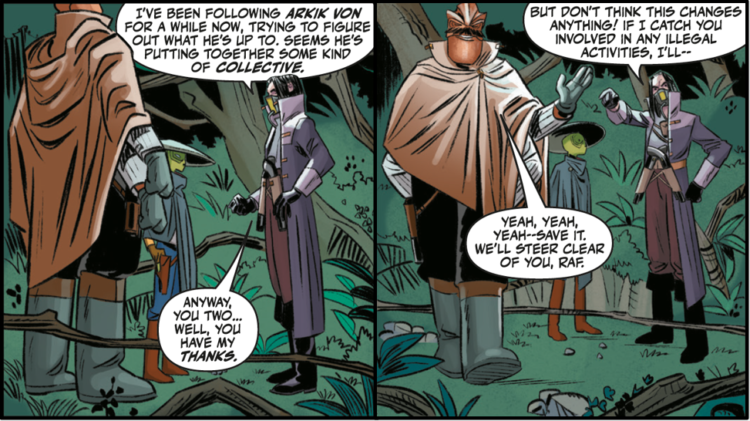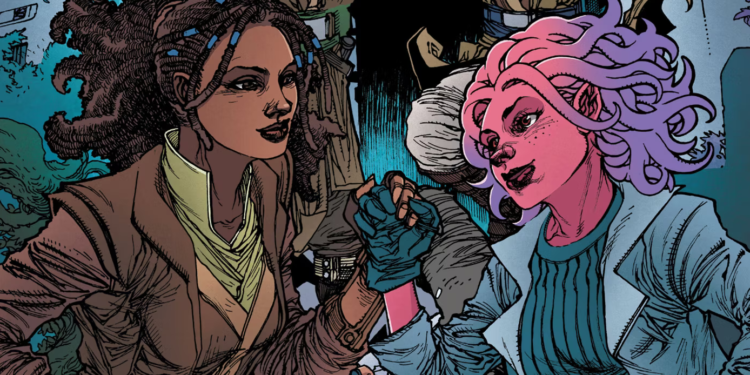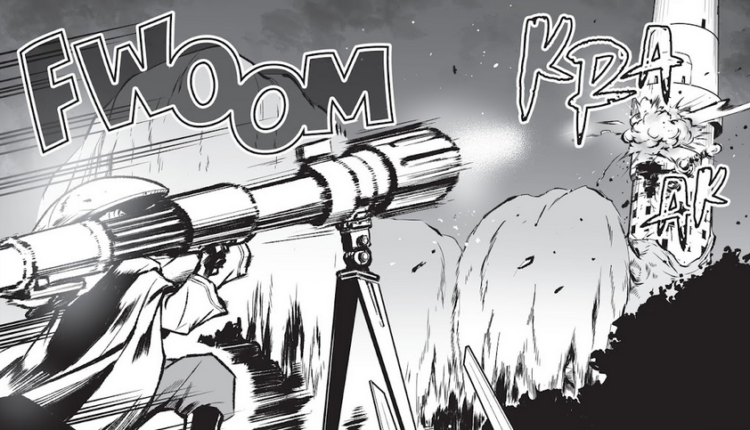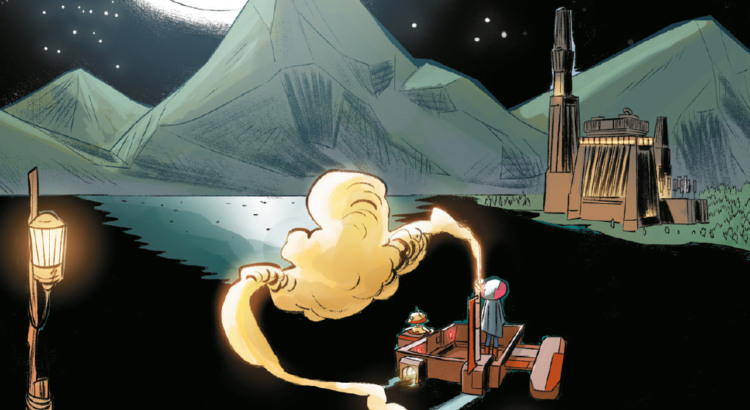Content Warning: spoilers for Adventures #1 and discussions of real-world queerphobic violence
Maybe it’s because I’m queer. Maybe it’s because of Lula, Zeen, Kantam, the very queerness of The High Republic Adventures Phase I run. But ever since we received the preview of a young, gremlin Sav Malagán in the first issue of Phase II, saying this about Maz Kanata’s castle –
“I head to a place where no one bugs me about meditating or following rules, where I can be whoever I want, whatever I want, or even disappear. The only place I can really be myself.”
– I can’t stop thinking, “queer bar.”
Now that we have the full comic, it’s embedded in my perspective. I do not know if writer Daniel José Older or artist Toni Bruno intended this reading, but for me as an aromantic asexual trans man, it felt inescapable.
We join Sav Malagán on the sidelines of this queer bar, watching the various characters who represent the person she wants to become. She tells herself their stories and hopes one day to be counted among them. The pirate outfit she dons at the beginning is perhaps even inspired by one of these elder queers she idolizes; the one she scampers after to learn about how she can live her full identity.

Within the queer bar, there’s an inherent distrust of the pirate hunter Inspector Raf Thatchburn, despite Maz seeing something decent in him, because his job inherently involves violence against the community. Y’know…. ACAB.
Our introduction to Raf is through an argument he is having with the one character (thus far) who has been confirmed as canonically queer by Older. Raf makes it clear that he’d be more than happy to arrest Alak and doesn’t bother to confirm who threw the mug (it was Sav, gremlin that she is) before charging the gay pirate.
“When it comes down to a dispute between one of my most trusted men and the law, who do you think I’m going to believe?” Maz scolds Raf after breaking up the fight.
In real life, “no cops at Pride” has long been a demand from the queer community. A demand that frequently falls on unlistening ears, but the fact remains that Pride was birthed from a riot against police violence. It was not so long ago that the law required our arrest. Discrimination and profiling of queer people, especially queer people of color, never stopped. And laws are currently being written, debated, and even signed in order to make our very existence illegal once again.
So, if there are no cops at Pride, who protects us?
We do.
In The High Republic Adventures, Dexter Jettster watched an armed cop storm out of a queer bar in a rage after an altercation with a gay man. Having cause to suspect violence, Dex follows with intent to protect the community he leaves behind at Maz’s. Sav follows Dex and insists on sticking with him, because it’s dangerous to go alone (take a gremlin child).
We protect us.
Raf is later shown to not have any immediate designs against the community at the queer bar. Dex and Sav join his fight against their shared enemy – the Dank Graks – in the woods. But afterwards, he still uses precious breath to threaten Dex and gives no indication that he would have returned to warn Maz of the Dank Graks. No matter what we contribute to the world, for some people, it’s never enough to warrant their protection or respect.
It’s up to Dex and Sav.
We protect us.

Up until this point, I have been making a connection between queerness and Sav Malagán’s desire to be a pirate, but there’s also parallels to be drawn between queerness and her status as a padawan. Let’s take a step back into the larger context of The High Republic.
In the current Phase II of The High Republic, our main, overarching villain is a Force cult called the Path of the Open Hand, which believes that any use of the Force, even for good, will leave something else bereft. They demand that Force sensitives suppress themselves or some unknown spirit will enact retribution upon the galaxy.
Path of Deceit, the first novel of Phase II, gave us an entire book of a Jedi and a member of this cult having a philosophical debate. It’s something that may start off sounding like a benign disagreement, but the moment that the Path has the power to eradicate the people they have labeled as the dangerous other (in direct contrast to the othered people’s actual actions), they wield it and call it the will of the divine.
As a queer Christian, let me be blunt in saying: I grew up hearing this from people in my life. I still do. It’s not just personal; it’s systemic. Bigots in the church, pulpit, and elected offices have spent decades pointing to us as a spiritual and societal cancer. The Path’s justification rings sharply of the negligence of the AIDS crisis, where the nation felt justified in our mass death, because this was just God’s wrath on our sinful natures.
Now, this is all a great deal of metaphor and coding, potentially open to other interpretations, but let us remember something very specific: this is not where we first met the Path. This is not where we first met their philosophy. We are introduced to both through the Path’s future remnants, in a story where the Force is a blatant metaphor for queerness in an explicitly queer character.

In The High Republic Adventures Phase 1, a full century and a half after Sav Malagán’s padawan adventures, we meet Zeen Mrala. A gay teenager that lives within one of the remnant communities of the Path, closeting herself and her Force-sensitivity because of their beliefs. She grows up believing this inherent part of herself is, evil, unnatural, an abomination.
Then, Zeen meets the Jedi. She sees them living their Force-sensitive lives freely, using it for good, not evil. So she steps in to help them, and uses the Force. The rest of the run has repeated, blunt parallels to queerness, including a former friend trying to convince her to go back in the closet.
Essentially, through Zeen, The High Republic – and The High Republic Adventures in particular – frames the Force as a direct metaphor for embracing one’s queer self, the self that the overarching villains of this era wish to suppress.
What does this mean for Sav Malagán and this queer lens I’ve been applying across this essay? It means that there are two instances in this comic where Sav’s Jedi identity itself reflects queerness.
The first example is that both Maz inviting Sav to join the pirate crew and Sav drawing her lightsabers in real battle for the first time are noted by Sav to be moments that she’s waited her whole life for. At this time, she gives one more weight than the other, but she still feels connected to herself in a new way in the moment that she fights as a Jedi.
The second example is that, despite fully entering the queer community that she has been watching from the sidelines, a part of Sav is still closeted from them. Dex recounting the fight against the Dank Graks without mentioning Sav’s lightsaber or padawanship reads strongly as him agreeing not to “out” her to the other pirates. This, too, is a queer experience.

Different identities under the queer umbrella may face bias from those who ought to be on our side. To use examples with which I am familiar, the exclusion of aromantic and asexual people in queer spaces often affects how an aro or ace person approaches the community. I have seen many a-spec folks describe this closeting of themselves even with other queer people. For example, an aromantic bisexual person might mention they are bi, but keep the aro part of themselves hidden. An ace lesbian might proudly declare her sapphic nature to everyone, but only mention her asexuality within an explicitly ace-inclusive space. And this sort of exclusion from queerness has been experienced by multiple other identities – bi and trans for two other examples – or intersections of identity – such as race, disability, body shape, etc.
Sav openly expressing one part of her identity but still keeping the other hidden is a reflection of duality that many queer people still have to maintain, even within queer spaces, to be included.
There can also be internal pressure, which we know Sav is experiencing from her opening monologue. As much as she reveled in this one moment of being a Jedi, there’s still the baggage that she carries from what a Jedi is “supposed” to look like. This is another common queer experience, especially a trans experience.
Trans people might struggle accepting ourselves as our true gender (or lack thereof) because we don’t fit the “right” feminine, masculine, or androgynous expectations. You can find multiple essays from me online discussing aromanticism and asexuality as a “woman”, right up until two months before I came out as trans. Like Sav attempting to reconcile the pirate and padawan parts of herself, the asexual and transmasculine sides of me initially felt disjointed, like I wasn’t allowed to be both.
Now, thanks to Phase I, we do know that Sav goes on to become a Jedi Master (a delightful gremlin of a master) who keeps close ties to Maz Kanata’s community and remains a bit of a gunslinger.

While we don’t know what that journey will look like – that’s the point of this comic run – we know that she will find a way to reconcile these parts of herself. She will find a way to become someone whole and wholly unique as Sav Malagán.
And ain’t that just queer?


2 thoughts to “Sav Malagán, Community, & Identity – A Queer Lens on The High Republic Adventures”
Comments are closed.